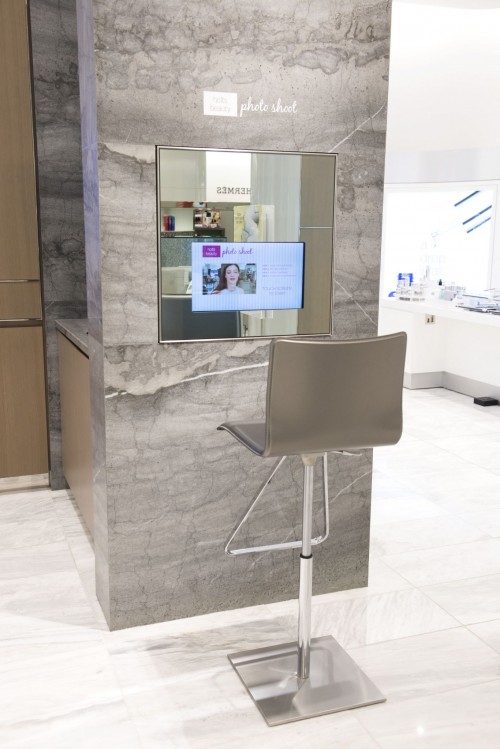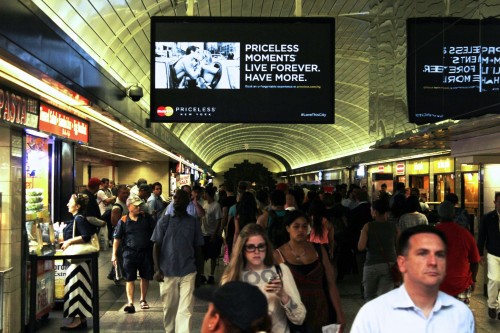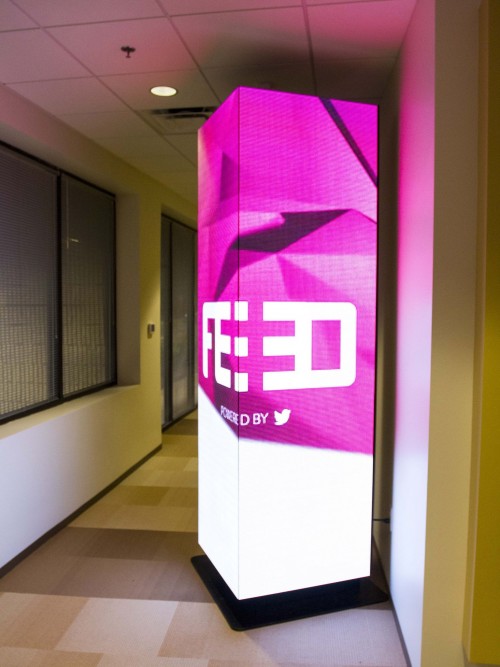Digital Signage: Keeping retail dynamic
by all | 18 April 2014 8:30 am
 [1]
[1]Photos courtesy NanoLumens
By Katherine Moore
Today’s retailers are battling a threat known as ‘showrooming.’ This practice involves potential customers inspecting products in a traditional bricks-and-mortar store, but then ordering the same items online, instead, if they can find lower pricing. Whether through smart phones, tablets or personal computers (PCs), this threat always seems to resurface just as retailers are making it to the end of a shopping season or about to reach their next sales goal.
While showrooming is perceived to be a much more powerful threat than it really is, it has been shown to negatively affect sales numbers and conversion rates. One of the best ways for retailers to overcome it is by embracing digital signage technology and creating captivating in-store displays.
 [2]
[2]By going digital and emphasizing dynamic content, retailers can help prevent ‘showrooming,’ whereby customers buy products online instead of in stores.
The heart of retail
As sign shops are in the perfect position to exemplify, rather than focusing only on the problem of showrooming itself, it is important for retailers to get back to the heart of their business: connecting a brand to customers. Like sign-based advertising, after all, retailing involves introducing people to products and services they want or need to better their lives. Retail environments should reflect this vision.
So, given customers are already using their smartphones in stores, bricks-and-mortar stores can reflect—rather than reject—this trend, by incorporating Quick Response (QR) codes and references to Pinterest and other social media, to bring the personalized experience of online commerce to the traditional retail environment.
Similarly, while static posters, marquees and billboards have been the hallmarks of retail advertising for decades, it is also important to use digital displays to communicate with ad-savvy customers. When a retailer only has a few seconds to engage a consumer, it is too easy for static ads to be translated as ‘white noise,’ as customers pass by without even glancing. Dynamic content, especially when presented in distinctive shapes and sizes, is harder to ignore. Light-emitting diode (LED) displays, especially, can present a bright image, even in an environment with high ambient light levels, such as a mall corridor or a street-facing storefront.
Indeed, retailers need no longer be limited to static images. Instead, they can maximize their real estate with everything from static wayfinding information and sales pricing to how-to videos and digital kiosks. ‘Storytelling’ is essential to successful marketing and cannot be summed up in a single image. Digital displays let retailers more fully share who they are, what they do and why they do it.
By creating an immersive in-store experience with eye-catching digital signage and creative content, sign shops can help retailers reach customers in the way they want to be reached, providing a memorable shopping experience they will want to repeat. It is possible, without bombarding them unnecessarily, to create a connection and conversation about the products and services they need.
Webrooming
Even when they understand the benefits of both static and digital signage, some retailers continue to worry new investments in these areas are futile given the growth of showrooming. In the constant battle with online sales, going digital indoors may not seem like enough of a weapon. Fortunately, there is an equally important trend known as ‘webrooming,’ which is changing the way customers think about bricks-and-mortar stores.
According to a survey undertaken by BuzzCity, a mobile Internet advertising company, 59 per cent of all consumers who shop online also continue to shop in stores. In many cases, they are visiting bricks-and-mortar locations to see in person what they say about retailers’ brands.
Market research firm Harris Interactive recently polled consumers about these habits. While the study found 46 per cent admitted to showrooming during the 2013 holiday season, a more significant 69 per cent were webrooming. In other words, most shoppers were looking online for pricing information, then heading to stores to make their purchases in person.
These consumers are responding to high-quality in-store experiences, including retailers’ investments in static and digital signage, along with strong customer service and other attributes. The quality of these experiences is essential to brand success and attracting online shoppers.
Answering customer priorities
 [3]
[3]Light-emitting diode (LED) displays can present a bright image, even in an environment with high ambient light levels, such as a mall corridor.
While the addition of digital signage can enhance the in-store experience, it is just as important to know how to use the technology appropriately.
The aforementioned BuzzCity poll found most consumers were looking for variety (33 per cent), ease of store navigation when searching for products (32 per cent) and discounts (24 per cent) in bricks-and-mortar shopping environments. Digital displays can address all of these priorities.
Dynamic content can showcase more combinations of products than a static sign could. Examples could include a fashion store’s ‘look book’ of various pieces of clothing, put together in different ensembles, or a grocery store’s featured recipes, listing various ingredients. The idea is to offer in-store products in interesting ways customers can apply to their own lives.
Store navigation can be enhanced by periodically displaying wayfinding information, particularly to highlight the locations of specially promoted items. In this sense, digital signage can be updated to direct customers to purchase the right items at the right times.
Along the same lines, digital signs are well-suited for announcing discounts, as they can be updated in real time as new sales periods begin and end.
Shaping the message
It may seem like all retailers have already gone digital, of course, and the day may soon come when dynamic displays outnumber their static counterparts in many retail environments. It is therefore becoming important to stay ahead of the pack by investing in ‘outside-the-box’ display styles.
This represents a major opportunity for signage providers to work with retailers to choose the best technologies to convey their brands and to stand out from the competition. Smoothly curved displays, for example, are naturally eye-catching and engaging, as curves are always more intriguing than straight lines.
It is even possible today to wrap a digital display in a cylindrical shape around a building column, adding branding to an in-store surface that previously went unused. One of the primary advantages of such an installation is 360-degree viewing angles, helping the retailer’s message reach more customers at once.
There has also been a trend toward narrowing screen bezels, so there are no visible ‘seams’ in video walls.
Controlling the challenge
Even with the current popularity of digital signage, some retailers are daunted by the expense and challenge of implementing a new network of screens. The degree of these burdens will depend, however, on how the signage provider offers to integrate the technology.
 [4]
[4]Wrapping structures allows for greater viewing angles.
In many ways, digital signage can prove simpler than printed graphics. When static ads are replaced as retailers introduce new products or as the seasons change, after all, retailers have to pay to produce, distribute and install the graphics. With digital signage, on the other hand, it becomes possible to simply send out a file and have it uploaded to the network. The style, design and focus of the retailer’s message can be changed without asking an employee to climb a ladder and even without incurring additional costs. Rather, the signage provider can charge one upfront fee to manage the network, updating it whenever needed without any hassle. This gives a retailer a sign that changes with the sales.
There will be some maintenance costs, which is where the choice of technology becomes crucial. In addition to being bright, LEDs are highly energy-efficient, allowing a large-format display to be operated with the same amount of power as a hairdryer, and durable, requiring very little servicing. In fact, some of today’s digital signs will run 24-7 for more than 10 years straight, without ever being turned off, and will display a bright, crisp image throughout their operating life. Further, LEDs produce almost no heat, so there is no need to increase the level of air conditioning to accommodate them.
Comfort and excitement
By changing in-store environments, sign shops have the opportunity to help retailers battle their perceived threats, including showrooming and competition from other bricks-and-mortar shops. Today’s digital displays can allow stores to remain familiar and comfortable to their customers while simultaneously surpassing their expectations with highly engaging content. Both of these accomplishments are key in keeping them coming back for more.
Katherine Moore is marketing content manager for NanoLumens, which manufactures flat, curved, thin and flexible digital displays. For more information, visit www.nanolumens.com[5].
- [Image]: http://www.signmedia.ca/wp-content/uploads/2014/03/Panoz-NanoSlim.jpg
- [Image]: http://www.signmedia.ca/wp-content/uploads/2014/03/a4-PhotoShoot.jpg
- [Image]: http://www.signmedia.ca/wp-content/uploads/2014/03/CBS-Outdoor.jpg
- [Image]: http://www.signmedia.ca/wp-content/uploads/2014/03/Revised-Avyve.jpg
- www.nanolumens.com: http://www.nanolumens.com
Source URL: https://www.signmedia.ca/digital-signage-keeping-retail-dynamic/